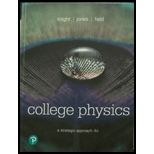
Concept explainers
Problems 39 through 45 are motion problems similar to those you will learn to solve in Chapter 2. For now, simply interpret the problem by drawing a motion diagram showing the object's position and its velocity vectors. Do not solve these problems or do any mathematics.
40. Billy drops a watermelon from the top of a three-story building, 10 m above the sidewalk. How fast is the watermelon going when it hits?
Want to see the full answer?
Check out a sample textbook solution
Chapter 1 Solutions
College Physics: A Strategic Approach (4th Edition)
Additional Science Textbook Solutions
Chemistry: Structure and Properties (2nd Edition)
Genetic Analysis: An Integrated Approach (3rd Edition)
Human Physiology: An Integrated Approach (8th Edition)
Human Biology: Concepts and Current Issues (8th Edition)
Chemistry: An Introduction to General, Organic, and Biological Chemistry (13th Edition)
Microbiology with Diseases by Body System (5th Edition)
- 5.4 ⚫ BIO Injuries to the Spinal Column. In the treatment of spine injuries, it is often necessary to provide tension along the spi- nal column to stretch the backbone. One device for doing this is the Stryker frame (Fig. E5.4a, next page). A weight W is attached to the patient (sometimes around a neck collar, Fig. E5.4b), and fric- tion between the person's body and the bed prevents sliding. (a) If the coefficient of static friction between a 78.5 kg patient's body and the bed is 0.75, what is the maximum traction force along the spi- nal column that W can provide without causing the patient to slide? (b) Under the conditions of maximum traction, what is the tension in each cable attached to the neck collar? Figure E5.4 (a) (b) W 65° 65°arrow_forwardThe correct answers are a) 367 hours, b) 7.42*10^9 Bq, c) 1.10*10^10 Bq, and d) 7.42*10^9 Bq. Yes I am positve they are correct. Please dont make any math errors to force it to fit. Please dont act like other solutiosn where you vaugley state soemthing and then go thus, *correct answer*. I really want to learn how to properly solve this please.arrow_forwardI. How many significant figures are in the following: 1. 493 = 3 2. .0005 = | 3. 1,000,101 4. 5.00 5. 2.1 × 106 6. 1,000 7. 52.098 8. 0.00008550 9. 21 10.1nx=8.817arrow_forward
 College PhysicsPhysicsISBN:9781938168000Author:Paul Peter Urone, Roger HinrichsPublisher:OpenStax College
College PhysicsPhysicsISBN:9781938168000Author:Paul Peter Urone, Roger HinrichsPublisher:OpenStax College Physics for Scientists and Engineers with Modern ...PhysicsISBN:9781337553292Author:Raymond A. Serway, John W. JewettPublisher:Cengage Learning
Physics for Scientists and Engineers with Modern ...PhysicsISBN:9781337553292Author:Raymond A. Serway, John W. JewettPublisher:Cengage Learning College PhysicsPhysicsISBN:9781305952300Author:Raymond A. Serway, Chris VuillePublisher:Cengage Learning
College PhysicsPhysicsISBN:9781305952300Author:Raymond A. Serway, Chris VuillePublisher:Cengage Learning University Physics Volume 1PhysicsISBN:9781938168277Author:William Moebs, Samuel J. Ling, Jeff SannyPublisher:OpenStax - Rice University
University Physics Volume 1PhysicsISBN:9781938168277Author:William Moebs, Samuel J. Ling, Jeff SannyPublisher:OpenStax - Rice University Physics for Scientists and Engineers: Foundations...PhysicsISBN:9781133939146Author:Katz, Debora M.Publisher:Cengage Learning
Physics for Scientists and Engineers: Foundations...PhysicsISBN:9781133939146Author:Katz, Debora M.Publisher:Cengage Learning Principles of Physics: A Calculus-Based TextPhysicsISBN:9781133104261Author:Raymond A. Serway, John W. JewettPublisher:Cengage Learning
Principles of Physics: A Calculus-Based TextPhysicsISBN:9781133104261Author:Raymond A. Serway, John W. JewettPublisher:Cengage Learning





